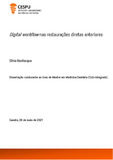| dc.contributor.advisor | GUIMARÃES, MAFALDA MARIA CALHEIROS LOBO DUARTE PINTO GUIMARÃES | |
| dc.contributor.author | Bevilacqua, Silvia | |
| dc.date.accessioned | 2021-11-18T10:17:08Z | |
| dc.date.available | 2021-11-18T10:17:08Z | |
| dc.date.issued | 2021 | |
| dc.identifier.uri | http://hdl.handle.net/20.500.11816/3701 | |
| dc.description.abstract | Introdução: As restaurações no setor anterior têm sido desde sempre um grande desafio para o médico dentista. A abordagem desses problemas pode ser exequível com restaurações diretas ou indiretas e seguindo etapas de trabalho e planeamento analógicas ou digitais. Em particular, as restaurações diretas são uma opção de tratamento minimamente invasiva, econômica e de fácil reintervenção.
Objetivos: Este trabalho visa investigar, com base na literatura, se a utilização de um fluxo de trabalho totalmente digital, no planeamento das restaurações diretas anteriores, representa uma abordagem vantajosa, normalizável e previsível em comparação com a técnica analógica.
Materiais e métodos: Pesquisa na base de dados PubMed e seleção dos artigos científicos em inglês, com limitação temporal dos últimos 10 anos, recorrendo às seguintes palavras-chave: “smile design”, “silicon índex”, “3D printing”, “digital workflow”, “intraoral scanner” e “direct restoration”
Discussão: A medicina dentária contemporânea está fortemente ligada à era digital, que pode oferecer soluções rápidas de copy-paste para a restauração direta dos dentes anteriores. Tecnologias digitais tais como scanner intraorais (IOS), scanner faciais (EOS), software de desenho assistido (CAD) e procedimentos de fabrico aditivos (AM) podem, de facto, ajudar na elaboração de restaurações compostas diretas.
Conclusões: Os artigos analisados demonstram como as restaurações guiadas digitalmente podem ajudar o médico dentista, especialmente os mais inexperientes, a conseguir restaurações previsíveis na forma e valor, poupando tempo e materiais. A ajuda da tecnologia tem como limitações o elevado custo dos materiais, a ampla curva de aprendizagem e, até à data, a impossibilidade de reprodução da textura vestibular dentária, dependente do operador. | pt_PT |
| dc.description.abstract | Introduction: Restorations of the anterior sector have always been a great challenge for the dentist. The approach to these issues can be done with direct or indirect restorations and following traditional or digital workflow. In particular, direct restorations are a minimally invasive, cost-effective and easily reinterventable treatment option.
Aims: This paper aims to investigate, based on the literature, whether the use of a fully digital workflow in planning anterior direct restorations represents an advantageous, standardizable and predictable approach compared to the analog technique.
Materials and methods: Search of the PubMed database and selection of scientific articles in English, with a time limitation of the last 10 years, using the following keywords: "smile design", "silicon index", "3D printing", "digital workflow", "intraoral scanner" and "direct restoration”.
Discussion: Contemporary dentistry is strongly linked to digital age, which can offer fast "copy-paste" solutions for direct restoration of anterior teeth. Digital technologies such as intraoral scanner (IOS), facial scanner (EOS), assisted design software (CAD), and additive manufacturing (AM) procedures can indeed help in the preparation of direct composite restorations.
Conclusions: The articles reviewed demonstrate how digitally guided restorations can help the dentist, especially the inexperienced, to achieve restorations that are predictable in shape and value, saving time and materials. The help of the technology has as limitations the high cost of materials, the large learning curve and, to date, the impossibility of reproducing the surface texture, still operator-dependent. | pt_PT |
| dc.language.iso | por | pt_PT |
| dc.rights | info:eu-repo/semantics/openAccess | pt_PT |
| dc.subject | Smile design | pt_PT |
| dc.subject | Silicon index | pt_PT |
| dc.subject | 3D printing | pt_PT |
| dc.subject | Digital workflow | pt_PT |
| dc.subject | Intraoral scanner | pt_PT |
| dc.subject | Direct restoration | pt_PT |
| dc.title | Digital workflow nas restaurações diretas anteriores | pt_PT |
| dc.type | info:eu-repo/semantics/masterThesis | pt_PT |
| dc.identifier.tid | 202781275 | pt_PT |
| thesis.degree.name | Mestrado em Medicina Dentária | pt_PT |

